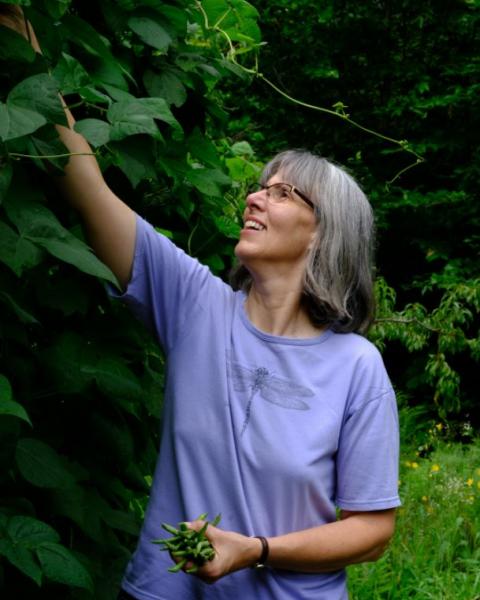Germination
8-12 days
Planting
Direct sow 5-6 seeds ¾-1" deep, 3-4' apart in rows 8-10' apart when the soil temperature is between 60-70℉ and the chance of frost has past. Thin to the healthiest plant. Provide protective coverings if the temperature nears freezing. Plant in rich organic soil kept moist at all times. Avoid wetting the foliage, as this can cause disease. When the vines begin to develop, add a layer of mulch to conserve moisture and control weeds; mulch also keeps the fruit clean and protected rot organisms in the soil. By midsummer, pinch off all the blooms to concentrate the plant's energy on the developing squashes.
Harvesting
90-100 days. When ripe the stem begins to dry and the skin becomes too hard to pierce with a fingernail. Cut the stem with a sharp knife, at a length of 2-3". Store in a cool, dry place.
Description
Anna Swartz squash is well-known for its hard shell and being an excellent keeper. Its flesh is thick, orange, and said to taste somewhat like sweet potatoes. The flowers are bee pollinated. The squashes usually mature at 5-8 pounds with dark skin, a small seed cavity and tear drop shape.
Profile
Planting Depth: 3/4-1 inch
Soil Temperature: 60-70˚F for germination
Germination: 8-12 days
Plant Spacing: 3-4 feet
Row Spacing: 8-10 feet
Maturity: 90-100 days
Soil: Moist, well-drained, slightly acid
Growing Habit: Vine, 10-12 feet
Sun: Full sun (minimum 6 hours)
Fruit Size: Around 5-8 lbs.
History
Elizabeth Hubbard, a washerwoman for the Gregory family in Marblehead, Massachusetts, gave her employer the seed for an heirloom squash. J. H. Gregory immediately named the squash "Hubbard," saying that Mrs. Hubbard was "a good, humble soul, and it pleases me to think that the name of such a one had become, without any intent of hers, famous."
The Anna Swartz Hubbard squash is an heirloom variety that was cultivated by Anna Swartz of Pennsylvania in the 1950s. She gave the seed to Seed Savers Exchange for commercial introduction in 1999.
Connection to Extension
Anna Swartz hubbard is one of the seeds offered by Strawbery Banke Museum through our free seed for education program.
This planting guide was created through partnership among Strawbery Banke Museum, New Hampshire School & Youth Garden Network, New Hampshire Master Gardener Alumni Association and UNH Extension Master Gardeners.
